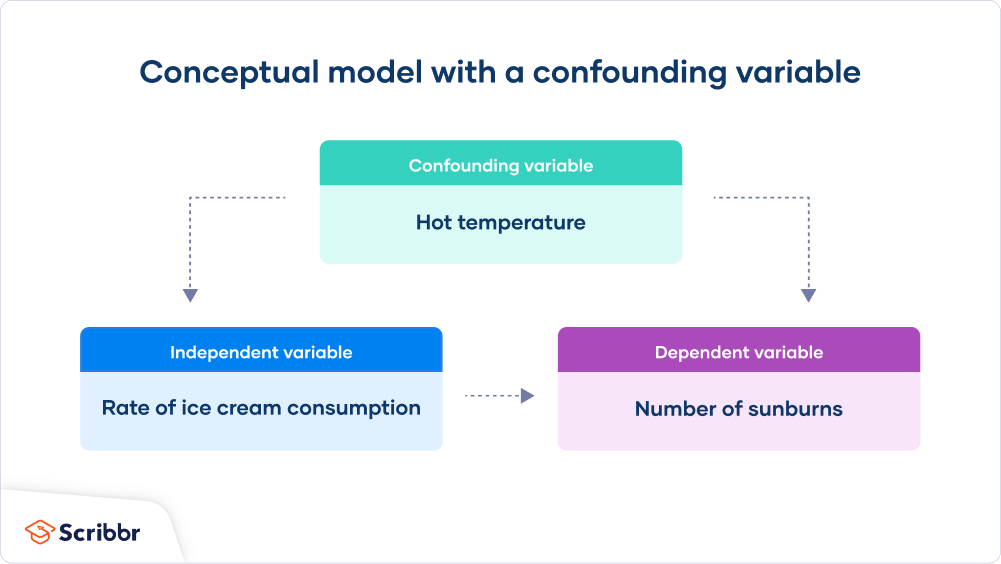Confounding Variables | Definition, Examples & Controls
In research that investigates a potential cause-and-effect relationship, a confounding variable is an unmeasured third variable that influences both the supposed cause and the supposed effect.
It’s important to consider potential confounding variables and account for them in your research design to ensure your results are valid.
What is a confounding variable?
Confounding variables (aka confounders or confounding factors) are a type of extraneous variable related to a study’s independent and dependent variables. A variable must meet two conditions to be a confounder:
- It must be correlated with the independent variable. This may be a causal relationship, but it does not have to be.
- It must be causally related to the dependent variable.
Here, the confounding variable is temperature: high temperatures cause people to both eat more ice cream and spend more time outdoors under the sun, resulting in more sunburns.

Why confounding variables matter
To ensure the internal validity of your research, you must account for confounding variables. If you fail to do so, your results may not reflect the actual relationship between the variables that you are interested in.
For instance, you may find a cause-and-effect relationship that does not actually exist, because the effect you measure is caused by the confounding variable (and not by your independent variable).
Not necessarily. Perhaps counties with better job markets are more likely to raise their minimum wages, rather than the other way around. You must consider the prior employment trends in your analysis of the impact of the minimum wage on employment, or you might find a causal relationship where none exists.
Even if you correctly identify a cause-and-effect relationship, confounding variables can result in over- or underestimating the impact of your independent variable on your dependent variable.
How to reduce the impact of confounding variables
There are several methods of accounting for confounding variables. You can use the following methods when studying any type of subjects (humans, animals, plants, chemicals, etc). Each method has its own advantages and disadvantages.
Restriction
In this method, you restrict your treatment group by only including subjects with the same values of potential confounding factors.
Since these values do not differ among the subjects of your study, they cannot correlate with your independent variable and thus cannot confound the cause-and-effect relationship you are studying.
- Relatively easy to implement
- Restricts your sample a great deal
- You might fail to consider other potential confounders
Matching
In this method, you select a comparison group that matches with the treatment group. Each member of the comparison group should have a counterpart in the treatment group with the same values of potential confounders, but different independent variable values.
This allows you to eliminate the possibility that differences in confounding variables cause the variation in outcomes between the treatment and comparison group. If you have accounted for any potential confounders, you can thus conclude that the difference in the independent variable must be the cause of the variation in the dependent variable.
Each subject on a low-carb diet is matched with another subject with the same characteristics who is not on the diet. So for every 40-year-old highly educated man who follows a low-carb diet, you find another 40-year-old highly educated man who does not, to compare the weight loss between the two subjects. You do the same for all the other subjects in your treatment sample.
- Allows you to include more subjects than restriction
- Can prove difficult to implement since you need pairs of subjects that match on every potential confounding variable
- Other variables that you cannot match on might also be confounding variables
Statistical control
If you have already collected the data, you can include the possible confounders as control variables in your regression models; in this way, you will control for the impact of the confounding variable.
Any effect that the potential confounding variable has on the dependent variable will show up in the results of the regression and allow you to separate the impact of the independent variable.
- Easy to implement
- Can be performed after data collection
- You can only control for variables that you observe directly, but other confounding variables you have not accounted for might remain
Randomisation
Another way to minimise the impact of confounding variables is to randomise the values of your independent variable. For instance, if some of your participants are assigned to a treatment group while others are in a control group, you can randomly assign participants to each group.
Randomisation ensures that with a sufficiently large sample, all potential confounding variables (even those you cannot directly observe in your study) will have the same average value between different groups. Since these variables do not differ by group assignment, they cannot correlate with your independent variable and thus cannot confound your study.
Since this method allows you to account for all potential confounding variables, which is nearly impossible to do otherwise, it is often considered to be the best way to reduce the impact of confounding variables.
Randomisation guarantees that both your treatment (the low-carb-diet group) as well as your control group will have not only the same average age, education, and exercise levels, but also the same average values on other characteristics that you haven’t measured.
- Allows you to account for all possible confounding variables, including ones that you may not observe directly
- Considered the best method for minimising the impact of confounding variables
- Most difficult to carry out
- Must be implemented prior to beginning data collection
- You must ensure that only those in the treatment (and not control) group receive the treatment
Frequently asked questions about confounding variables
Cite this Scribbr article
If you want to cite this source, you can copy and paste the citation or click the ‘Cite this Scribbr article’ button to automatically add the citation to our free Reference Generator.
Thomas, L. (2023, April 12). Confounding Variables | Definition, Examples & Controls. Scribbr. Retrieved 14 April 2025, from https://www.scribbr.co.uk/research-methods/confounding-variable/
